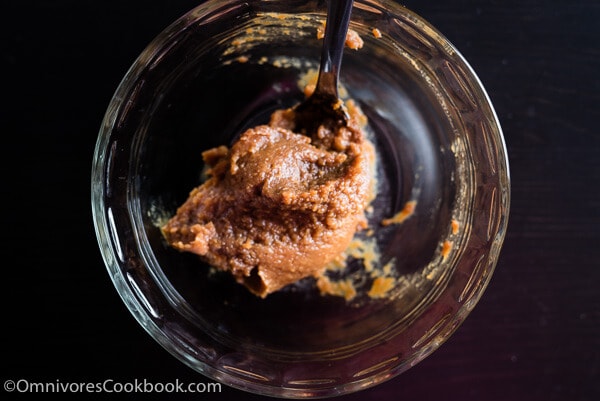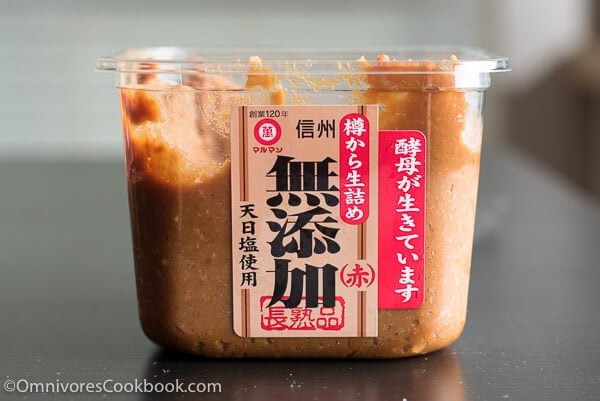
Miso (味噌) is a fermented soybean paste used primarily in Japanese cooking, although it can be wildly popular in other cuisines, as well. It is made from soybeans, grains (steamed rice or barley), salt, and koji culture (a fermentation starter). It is then left to ferment for six months to five years.
The texture and flavor of miso are a bit similar to that of the Chinese soybean paste (huang dou jiang, 黄豆酱) and of the Korean Doenjang, but is slightly sweeter and more delicate than either.
There are many types of miso used in Japanese cooking, and they vary by ingredients, fermentation process, and region. To simplify things, we can generally categorize them by color – aka miso (red miso), shiro miso (white miso), and awase miso (mixed miso).
Red Miso (Aka Miso, 赤味噌)
It is made from about 70% soybeans and 30% rice or barley, with a long fermentation period (1 to 1.5 years). It results in a darker color and stronger, saltier flavor.
White Miso (Shiro Miso, 白味噌)
It is made from about 40% soybeans and 60% rice or barley, with a shorter fermentation period compared to red miso. Shiro Miso has a beige color, tastes slightly less salty, slightly sweeter, and is smoother in texture compared to red miso.
Blended Miso (Awase Miso, 合わせ味噌)
A combination of red miso and white miso, it’s all-purpose.
All of the miso pastes above can be used in miso soup, stir-fry, grilling, and marinating. But if a recipe does not indicate specially, it usually means mixed miso. A seafood marinade might call for white miso due to its milder taste. But I found that white miso can also be very tasty in soup and on grilled vegetables, too.
The choice as to which type of miso to cook with will depend on your personal tastes. You can start with mixed miso and try out different types to find out which one you like best.

To buy
You can find miso in Japanese markets and in most Korean and other Asian markets. Read the label and try to find one made from non-GMO ingredients and without MSG. When it comes to purchasing miso paste, price does matter. I tend to avoid the cheapest one on the shelf, because its flavor can be less delicate.
You can also purchase red miso, white miso, and awase miso (blended miso) on Amazon.
A note on buying: I have noticed that miso sold in the US commonly contains concentrated fish dashi. This type of miso is convenient if you only intend to make miso soup with it. If you’d like to experiment with miso in marinades, salad dressings, and sauces, it’s better to buy a variety that does not contain dashi or bonito, and purchase (or cook) the dashi separately.
To use
Miso soup is the most common route to take, but I use it with scallops and fish, too. My favorite recipes include miso ramen, and one where I used miso paste as a secret ingredient for the best beef rice bowl ever.
To store
Use a clean, dry spoon to scoop the miso every time you use it, to avoid contamination. And always store miso in the fridge. If you follow these guidelines, the miso will stay good for several months. Some people have reported they can keep it in the fridge for years without any problem. Please note that white miso generally has a shorter shelf life than red and mixed.
Once you get the idea of how to cook miso soup without a recipe, you will probably will finish a package of it within a few weeks, anyway.
